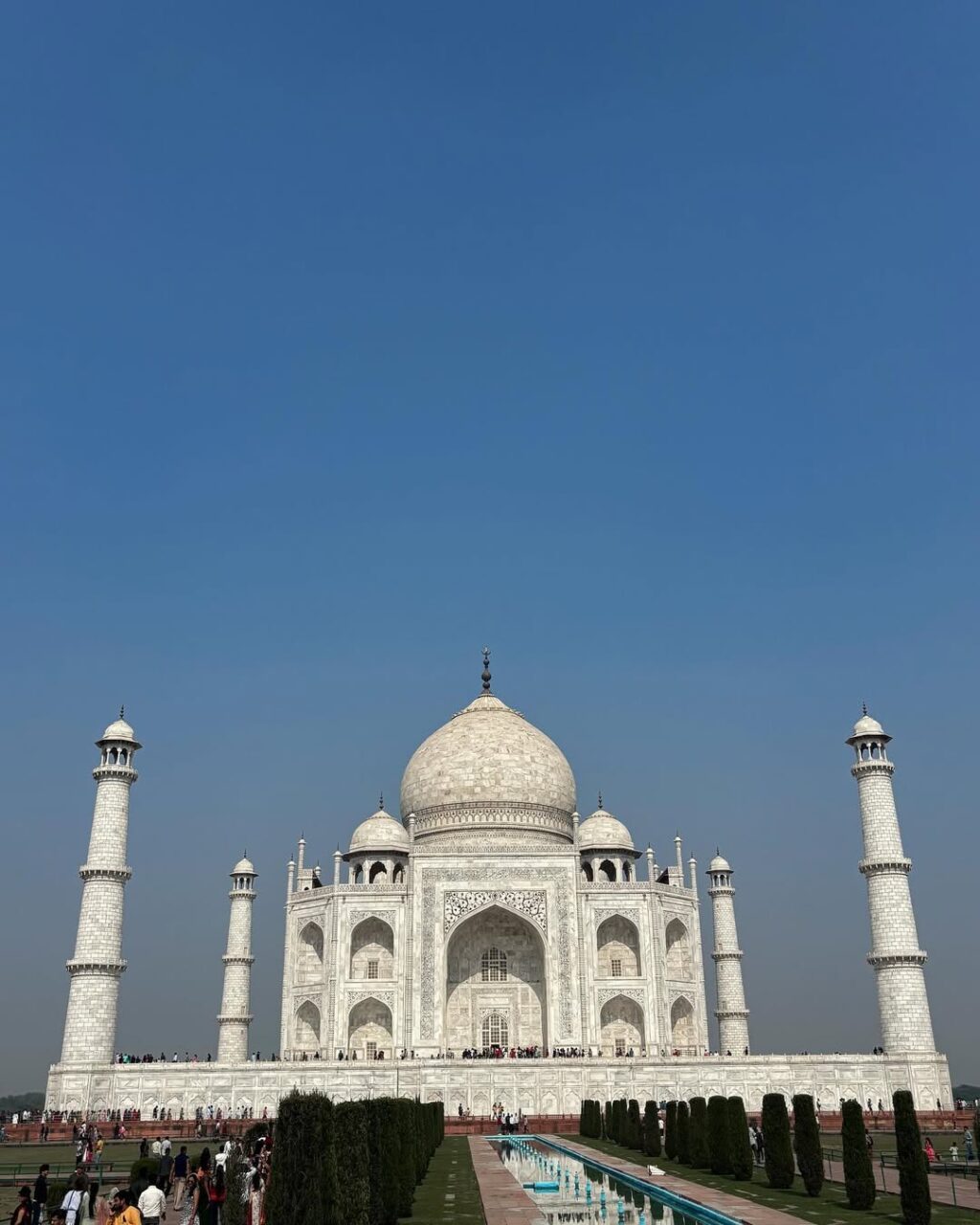
Introduction: Why Agra Should Be on Your Travel List
Agra, located in the northern state of Uttar Pradesh, is one of India’s most iconic travel destinations. Famous worldwide for the Taj Mahal, Agra offers much more than just a glimpse of this white marble marvel. Steeped in rich Mughal history, Agra is a city of stunning architecture, vibrant culture, and incredible local experiences. Whether you’re a history buff, a culture enthusiast, or just in love with India’s rich heritage, Agra promises an unforgettable journey.
Top Attractions in Agra
1. Taj Mahal: The Icon of Love
- Why Visit: The Taj Mahal, a UNESCO World Heritage Site, is undoubtedly the most famous landmark in Agra and one of the Seven Wonders of the World. Built by Emperor Shah Jahan in memory of his beloved wife Mumtaz Mahal, it stands as a timeless symbol of love and architectural brilliance.
- Top Highlights:
- The magnificent white marble structure reflecting the hues of the sky.
- Stunning views of the Taj Mahal from the reflecting pool.
- Tomb of Mumtaz Mahal and Emperor Shah Jahan inside the Taj.
- Visit during sunrise or sunset to capture breathtaking photos with softer lighting and fewer crowds.
- Travel Tip: The Taj Mahal opens at sunrise (6:00 AM) and remains open until sunset. The best time to visit is early morning for peace and the chance to watch the changing colors on the monument.
2. Agra Fort: A Majestic Mughal Fortress
- Why Visit: Just a short distance from the Taj Mahal, Agra Fort is a fortress of red sandstone that once served as the main residence of the Mughal emperors. With its grand gates, royal palaces, and beautiful gardens, this is a must-visit site to understand the power and opulence of the Mughal Empire.
- Top Highlights:
- Jahangir Palace: The residential area for Emperor Jahangir.
- Diwan-i-Khas: Hall of Private Audience, where the emperor held private meetings.
- Diwan-i-Aam: Hall of Public Audience, where the emperor addressed the public.
- View of the Taj Mahal from the Moti Masjid (Pearl Mosque) inside the fort.
- Travel Tip: Spend around 2-3 hours exploring the fort. Early mornings or late afternoons are the best time to avoid the heat and crowds.
3. Fatehpur Sikri: The Ghost City of the Mughals
- Why Visit: Located about 40 km from Agra, Fatehpur Sikri was briefly the capital of the Mughal Empire during the reign of Emperor Akbar. Today, it’s an abandoned city with some of the most stunning examples of Mughal architecture.
- Top Highlights:
- Buland Darwaza: The grand entrance gate, one of the largest in the world.
- Jama Masjid: An imposing mosque that is one of the finest examples of Mughal architecture.
- Panch Mahal: A five-story palace offering panoramic views of the city.
- Tomb of Salim Chishti: A revered Sufi shrine, which attracts many pilgrims.
- Travel Tip: Hire a guide for an informative tour of Fatehpur Sikri, as the history behind this site is complex and rich.
4. Mehtab Bagh: The Sunset View of the Taj Mahal
- Why Visit: Across the Yamuna River, Mehtab Bagh offers the best views of the Taj Mahal at sunset. It’s a peaceful garden complex where you can enjoy a less crowded view of the monument, perfect for photographers and those looking for a quiet escape.
- Top Highlights:
- Panoramic views of the Taj Mahal from the opposite side of the Yamuna River.
- A beautiful garden filled with fragrant flowers and greenery.
- Ideal for an evening stroll or a quiet sunset.
- Travel Tip: Bring a camera to capture stunning photos of the Taj Mahal from this unique angle.
5. Tomb of Itimad-ud-Daulah: The “Baby Taj”
- Why Visit: Known as the Baby Taj, the Tomb of Itimad-ud-Daulah is a smaller version of the Taj Mahal and an architectural gem in its own right. Built by Empress Nur Jahan for her father, it’s considered a precursor to the Taj Mahal in terms of design and marble work.
- Top Highlights:
- Intricate marble inlay work and carvings.
- Beautiful gardens and the surrounding Yamuna river view.
- Breathtaking symmetry and craftsmanship.
- Travel Tip: It’s less crowded compared to the Taj Mahal, making it a great spot for peaceful reflection.
Best Time to Visit Agra
- Winter (October to March): The ideal time to visit Agra is during the cooler months, as temperatures are more comfortable for sightseeing, with low humidity and cooler evenings.
- Tip: Visit early in the morning or late afternoon to avoid the midday heat.
- Summer (April to June): Temperatures can exceed 40°C (104°F), making it very hot to explore outdoors, but early morning and evening visits are still possible.
- Monsoon (July to September): While the rain brings cooler temperatures, it can also disrupt travel plans with sudden downpours.
Suggested Itinerary for Agra
Day 1:
- Morning: Visit the Taj Mahal at sunrise for a breathtaking view and fewer crowds.
- Late Morning: Explore the Agra Fort.
- Afternoon: Head to Mehtab Bagh for a peaceful retreat and sunset view of the Taj Mahal.
- Evening: Shop for souvenirs at the Sadar Bazaar or explore the vibrant streets of Agra.
Day 2:
- Morning: Visit Fatehpur Sikri, about 40 minutes from Agra.
- Afternoon: Explore the Tomb of Itimad-ud-Daulah and the Chini Ka Rauza (another historical tomb).
- Evening: Relax with a traditional Mughlai dinner at one of Agra’s famous restaurants, such as Pinch of Spice or Esphahan Restaurant.
How to Get to Agra
- By Air: The nearest airport is Agra Airport (Kheria Airport), though it has limited international flights. The best option is flying into Indira Gandhi International Airport in Delhi (about 3-4 hours drive to Agra).
- By Train: Agra is well-connected by train, with regular services from Delhi, Jaipur, and other major cities. The Gatimaan Express is a high-speed train connecting Delhi to Agra.
- By Road: Agra is accessible via the Yamuna Expressway from Delhi, making for a quick drive of about 3 hours. You can also hire a taxi or use ride-sharing apps.
Where to Stay in Agra
Luxury Hotels:
- The Oberoi Amarvilas: Offers unparalleled views of the Taj Mahal and exceptional service.
- ITC Mughal: A luxury hotel set within Mughal-inspired architecture, offering world-class amenities.
Mid-Range:
- Hotel Taj Resorts: A budget-friendly option with great proximity to the Taj Mahal.
- DoubleTree by Hilton: Offers modern amenities with a lovely garden.
Budget:
- Zostel Agra: Perfect for backpackers or solo travelers.
- Hotel Sidhartha: An affordable choice with good reviews and proximity to major attractions.
Travel Tips for Agra
- Book Tickets in Advance: Especially for the Taj Mahal, pre-book your tickets to avoid long queues.
- Carry Water: Agra can get very hot, so stay hydrated throughout the day.
- Respect Local Culture: Dress modestly when visiting religious sites and monuments.
FAQs (Frequently Asked Questions)
1. How much time do I need to visit Agra?
A 2-day trip is ideal to cover all major attractions, including the Taj Mahal, Agra Fort, and Fatehpur Sikri.
2. What is the best time to visit the Taj Mahal?
The Taj Mahal is best visited at sunrise when the crowds are fewer, and the lighting is perfect for photos.
3. Can I take a guide at the Taj Mahal?
Yes, you can hire a licensed guide
at the entrance. It’s recommended for a more enriching experience.
4. Is Agra safe for tourists?
Yes, Agra is generally safe for tourists. Exercise caution with your belongings, especially in crowded markets.
5. What should I wear in Agra?
Dress modestly and comfortably. Wear lightweight clothing, comfortable shoes, and a hat to protect from the sun.
Conclusion: Explore Agra’s Rich Heritage
Agra is a city of unmatched historical significance, from the majestic Taj Mahal to the glorious Agra Fort and Fatehpur Sikri. Whether you’re here for a day or a week, Agra promises to offer something for everyone — incredible views, fascinating history, and a rich cultural experience. Start planning your Agra adventure today and immerse yourself in one of India’s most iconic cities!



